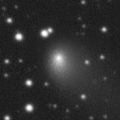
|
Now it is 9.6 mag (Jan. 5, Juan Jose Gonzalez). It brightens up to 8 mag in spring, and it is observable in good condition in the Northern Hemisphere. In the Southern Hemisphere, it is not observable until July.
Date(TT) R.A. (2000) Decl. Delta r Elong. m1 Best Time(A, h)
Jan. 11 2 56.43 56 28.1 1.541 2.210 120 9.2 19:35 (180, 68)
Jan. 18 2 39.55 57 2.8 1.565 2.151 113 9.1 18:51 (180, 68)
|

|
Now it is 11.5 mag (Dec. 27, Juan Jose Gonzalez). It stays bright as 12-13 mag until summer. But it becomes low in spring. In the Southern Hemisphere, it will never be observable again.
Date(TT) R.A. (2000) Decl. Delta r Elong. m1 Best Time(A, h)
Jan. 11 23 29.80 40 17.8 3.127 3.180 84 12.0 18:36 (112, 61)
Jan. 18 23 31.22 40 50.7 3.228 3.194 79 12.1 18:42 (113, 55)
|

|
Now it is 14.5 mag (Dec. 27, Toshihiko Ikemura, Hirohisa Sato).
Date(TT) R.A. (2000) Decl. Delta r Elong. m1 Best Time(A, h)
Jan. 11 0 32.15 12 59.4 5.827 5.785 82 13.5 18:36 ( 46, 61)
Jan. 18 0 35.03 13 8.8 5.939 5.786 76 13.6 18:42 ( 57, 56)
|
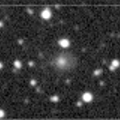
|
Now it is bright as 13.8 mag (Dec. 28, Chris Wyatt). It stays 14 mag until spring. It stays observable for a long time in the Southern Hemisphere. It is not observable until August in the Northern Hemisphere.
Date(TT) R.A. (2000) Decl. Delta r Elong. m1 Best Time(A, h)
Jan. 11 23 43.78 -78 48.1 3.781 3.458 63 14.0 18:36 ( 7,-25)
Jan. 18 0 7.60 -75 50.6 3.792 3.465 63 14.1 18:42 ( 9,-23)
|

|
Bright new comet. Now it is 14.8 mag (Dec. 30, Hidetaka Sato). It approaches to Sun down to 0.84 a.u. in March, then it brightens up to 12 mag. In the Northern Hemisphere, it stays observable for a long time, although it becomes extremely low in March. In the Southern Hemisphere, it is observable only until late January. It seems to be a fragment of C/1988 A1 (Liller), like C/1996 Q1 (Tabur) and C/2015 F3 (SWAN).
Date(TT) R.A. (2000) Decl. Delta r Elong. m1 Best Time(A, h)
Jan. 11 23 39.45 -21 44.2 1.662 1.418 58 14.6 18:36 ( 35, 25)
Jan. 18 23 40.19 -16 28.0 1.664 1.328 52 14.3 18:42 ( 46, 25)
|

|
In the Southern Hemisphere, it is observable at 14.5 mag from winter to spring. In the Northern Hemisphere, it is not observable until August when it fades down to 17 mag.
Date(TT) R.A. (2000) Decl. Delta r Elong. m1 Best Time(A, h)
Jan. 11 19 8.41 -72 25.3 2.531 2.051 50 14.6 5:38 (339,-34)
Jan. 18 20 11.60 -73 54.1 2.467 2.037 53 14.6 18:42 ( 20,-34)
|
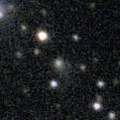
|
Now it is 14.1 mag (Dec. 28, Toshihiko Ikemura, Hirohisa Sato). In the Northern Hemisphere, it is observable at 14 mag in excellent condition in winter. It locates low in the Southern Hemisphere.
Date(TT) R.A. (2000) Decl. Delta r Elong. m1 Best Time(A, h)
Jan. 11 3 2.46 22 46.3 0.843 1.580 119 14.6 19:42 ( 0, 78)
Jan. 18 3 16.24 20 53.6 0.887 1.580 115 14.7 19:29 ( 0, 76)
|
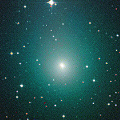
|
It brightened up to 8.3 mag in September (Sept. 20, Maik Meyer). Now it is fading. It has already faded down to 14.9 mag (Dec. 28, Chris Wyatt). In the Southern Hemisphere, it stays observable for a long time after this. In the Northern Hemisphere, it will never be observable again.
Date(TT) R.A. (2000) Decl. Delta r Elong. m1 Best Time(A, h)
Jan. 11 22 11.99 -46 41.9 2.902 2.262 41 14.7 18:36 ( 35, -6)
Jan. 18 22 20.02 -47 2.6 3.008 2.330 39 15.0 18:42 ( 38, -9)
|
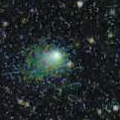
|
Now it is 15.1 mag (Dec. 27, Toshihiko Ikemura, Hirohisa Sato). Fading slowly. It is already unobservable in the Southern Hemisphre. It will be unobservable in early March also in the Northern Hemisphere.
Date(TT) R.A. (2000) Decl. Delta r Elong. m1 Best Time(A, h)
Jan. 11 22 37.53 -9 27.5 2.426 1.905 47 15.0 18:36 ( 56, 26)
Jan. 18 22 54.95 -8 12.4 2.498 1.929 44 15.1 18:42 ( 60, 24)
|

|
Now it is 14.6 mag (Dec. 28, Chris Wyatt). It will be fading slowly after this. In the Southern Hemisphere, it becomes low from February to March, but it stays observable for a long time. In the Northern Hemisphere, it is not observasble until summer in 2020.
Date(TT) R.A. (2000) Decl. Delta r Elong. m1 Best Time(A, h)
Jan. 11 22 20.42 -55 54.0 4.007 3.407 46 15.2 18:36 ( 28,-12)
Jan. 18 22 29.27 -53 38.6 4.076 3.436 43 15.3 18:42 ( 32,-13)
|
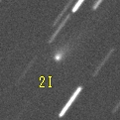
|
Now it is 14.3 mag (Dec. 27, Shigeki Murakami). The orbit is extremely hyperbolic with e=3.35. It is the first interstellar comet in history. It stays 15 mag until January. In the Northern Hemisphere, it will be unobservable in mid January. In the Southern Hemisphere, it is observable in excellent condition.
Date(TT) R.A. (2000) Decl. Delta r Elong. m1 Best Time(A, h)
Jan. 11 12 20.06 -42 58.6 1.962 2.140 86 15.3 5:01 ( 0, 12)
Jan. 18 12 29.28 -47 24.2 1.991 2.198 88 15.4 4:43 ( 0, 8)
|

|
It brightened up to 7.7 mag in June in 2018 (June 19, Juan Jose Gonzalez). Now it is fading. It has already faded down to 14.7 mag (Dec. 31, Toshihiko Ikemura, Hirohisa Sato). In the Southern Hemisphere, it stays observable for a long time until the comet will fade out. In the Northern Hemisphere, it stays low for a while.
Date(TT) R.A. (2000) Decl. Delta r Elong. m1 Best Time(A, h)
Jan. 11 5 54.06 -31 21.1 5.116 5.703 122 15.3 22:32 ( 0, 24)
Jan. 18 5 48.62 -30 19.6 5.198 5.758 120 15.4 21:59 ( 0, 25)
|

|
Now it is 16.0 mag (Jan. 1, Toshihiko Ikemura, Hirohisa Sato). It will brighten up to 13.5-14 mag from 2020 to 2021. It stays observable in good condition for a long time after this until 2020 summer.
Date(TT) R.A. (2000) Decl. Delta r Elong. m1 Best Time(A, h)
Jan. 11 13 7.18 11 41.3 3.243 3.528 98 15.6 5:38 (354, 66)
Jan. 18 13 10.86 11 51.9 3.129 3.510 104 15.4 5:24 ( 0, 67)
|
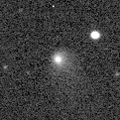
|
Now it is 14.8 mag (Dec. 28, Chris Wyatt). Fading slowly. It will be unobservable soon. It will appear in the morning sky in April in the Southern Hemisphere, or in June in the Northern Hemisphere.
Date(TT) R.A. (2000) Decl. Delta r Elong. m1 Best Time(A, h)
Jan. 11 23 9.69 -22 59.0 5.441 4.887 51 15.5 18:36 ( 41, 20)
Jan. 18 23 13.80 -21 42.3 5.556 4.921 45 15.6 18:42 ( 47, 17)
|
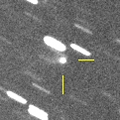
|
Now it is 14.8 mag (Dec. 23, Toshihiko Ikemura, Hirohisa Sato). It will fade out rapidly after this, and it will be fainter than 18 mag in March. In the Southern Hemisphere, it is already unobservable.
Date(TT) R.A. (2000) Decl. Delta r Elong. m1 Best Time(A, h)
Jan. 11 22 36.91 -1 34.2 2.283 1.825 50 15.6 18:36 ( 63, 31)
Jan. 18 22 52.76 0 33.8 2.345 1.839 48 15.8 18:42 ( 68, 29)
|
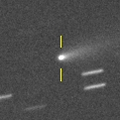
|
Now it is 15.6 mag (Dec. 27, Toshihiko Ikemura, Hirohisa Sato). It will fade out rapidly after this, and it will be fainter than 18 mag in March.
Date(TT) R.A. (2000) Decl. Delta r Elong. m1 Best Time(A, h)
Jan. 11 11 22.59 11 49.7 1.183 1.905 122 15.6 4:04 ( 0, 67)
Jan. 18 11 27.09 12 7.8 1.154 1.931 128 15.7 3:41 ( 0, 67)
|

|
Now it is 15.6 mag (Dec. 28, Toshihiko Ikemura, Hirohisa Sato). It will be fading gradually after this. It will be fainter than 18 mag in April.
Date(TT) R.A. (2000) Decl. Delta r Elong. m1 Best Time(A, h)
Jan. 11 9 31.42 5 30.5 2.064 2.928 145 15.6 2:13 ( 0, 60)
Jan. 18 9 26.74 5 46.3 2.047 2.960 153 15.7 1:41 ( 0, 61)
|
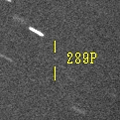
|
It approaches to Earth down to 0.09 a.u. in early January, and it was expected to brighten up to 15.5 mag. But actually, it is very faint as 18.0 mag (Dec. 29, Michael Jager). Michael Jager reported it has a faint coma with a diameter of 50-60 arcsec. It is obesrvable in excellent condition in the Northern Hemisphere. In the Southern Hemisphere, it is not observable until mid February.
Date(TT) R.A. (2000) Decl. Delta r Elong. m1 Best Time(A, h)
Jan. 11 0 45.14 53 43.8 0.091 1.006 101 15.9 18:36 (156, 67)
Jan. 18 4 22.98 71 12.1 0.102 1.040 121 15.6 20:57 (180, 54)
|
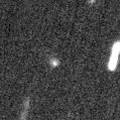
|
Now it is 15.6 mag (Jan. 4, Toshihiko Ikemura, Hirohisa Sato). It will brighten up to 10.5 mag from 2020 December to 2021 January. In the Northern Hemisphere, it stays observable in good condition while the comet will be brightening gradually, but it is not observable at the high light. In the Southern Hemisphere, it is not observable for a long time, but it will be observable in good condition after the high light.
Date(TT) R.A. (2000) Decl. Delta r Elong. m1 Best Time(A, h)
Jan. 11 17 59.68 60 26.9 4.149 4.167 84 15.8 5:38 (217, 37)
Jan. 18 18 7.23 60 43.7 4.080 4.103 84 15.7 5:38 (217, 39)
|
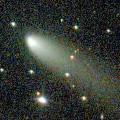
|
It brightened up to 11.4 mag in autumn (Nov. 10, Carlos Labordena). Now it is fading. It has already faded down to 14.8 mag (Dec. 28, Chris Wyatt). It is observable in excellent condition in the Northern Hemisphere. It stays locating extremely low in the Southern Hemisphere.
Date(TT) R.A. (2000) Decl. Delta r Elong. m1 Best Time(A, h)
Jan. 11 3 1.01 42 23.1 1.225 1.933 121 16.0 19:41 (180, 83)
Jan. 18 3 11.80 41 33.2 1.324 1.980 117 16.5 19:24 (180, 83)
|

|
Now it is 15.3 mag (Jan. 5, Toshihiko Ikemura, Hirohisa Sato). It is expected to be observable at 5-6 mag for a long time from 2022 to 2023. In the Northern Hemisphere, it is not observable at the high light from 2022 summer to 2023 summer. In the Southern Hemisphere, it stays unobservable for a while. But it will be observable in good condition at the high light.
Date(TT) R.A. (2000) Decl. Delta r Elong. m1 Best Time(A, h)
Jan. 11 17 54.84 45 26.2 10.336 10.051 70 16.1 5:38 (235, 34)
Jan. 18 17 58.44 45 32.7 10.271 10.002 71 16.1 5:38 (236, 38)
|

|
It will be fading slowly after this. In the Southern Hemisphere, it stays observable in good condition for a long time. It will never be observable after this in the Northern Hemisphere.
Date(TT) R.A. (2000) Decl. Delta r Elong. m1 Best Time(A, h)
Jan. 11 14 32.47 -64 16.6 4.991 4.631 63 16.1 5:38 (350,-11)
Jan. 18 14 30.61 -65 58.2 4.959 4.674 67 16.2 5:38 (353,-12)
|
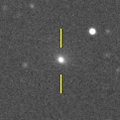
|
Now it is 15.4 mag (Dec. 23, Toshihiko Ikemura, Hirohisa Sato). It will be fading slowly after this.
Date(TT) R.A. (2000) Decl. Delta r Elong. m1 Best Time(A, h)
Jan. 11 0 41.06 -1 5.0 2.323 2.345 79 16.3 18:36 ( 30, 50)
Jan. 18 0 51.30 0 13.1 2.401 2.345 74 16.3 18:42 ( 39, 48)
|
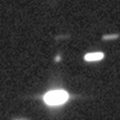
|
Now it is 17.0 mag (Jan. 3, Toshihiko Ikemura, Hirohisa Sato). It will brighten up to 13 mag in 2021. In 2020, it is observable at 15 mag in good condition from spring to summer.
Date(TT) R.A. (2000) Decl. Delta r Elong. m1 Best Time(A, h)
Jan. 11 14 53.39 -12 33.2 6.149 5.808 65 16.6 5:38 (325, 35)
Jan. 18 14 56.08 -13 7.8 5.998 5.764 71 16.5 5:38 (332, 37)
|

|
Now it is 17.5 mag (Dec. 28, Toshihiko Ikemura, Hirohisa Sato). It stays 16-17 mag for a long time until 2020. It is observable in good condition in the Northern Hemisphere. In the Southern Hemisphere, it is observable in the extremely low sky only in 2021 spring.
Date(TT) R.A. (2000) Decl. Delta r Elong. m1 Best Time(A, h)
Jan. 11 13 29.59 53 8.7 8.314 8.652 106 16.8 5:38 (195, 71)
Jan. 18 13 30.54 53 31.4 8.270 8.661 110 16.8 5:38 (183, 72)
|

|
Fading. It is observable at 17 mag in good condition in spring. But it will be fainter than 18 mag in June.
Date(TT) R.A. (2000) Decl. Delta r Elong. m1 Best Time(A, h)
Jan. 11 16 26.68 -8 43.8 3.187 2.588 45 16.8 5:38 (301, 24)
Jan. 18 16 39.05 -8 35.3 3.162 2.625 49 16.9 5:38 (304, 27)
|

|
Now it is 18.2 mag (Jan. 1, Toshihiko Ikemura, Hirohisa Sato). It will brighten very rapidly after this. It will brighten up to 8-9 mag from summer to autumn. It will be observable in excellent condition in the Southern Hemisphere. It locates very low around the high light in the Northern Hemisphere.
Date(TT) R.A. (2000) Decl. Delta r Elong. m1 Best Time(A, h)
Jan. 11 13 17.80 -3 53.5 2.564 2.754 90 17.2 5:38 (352, 51)
Jan. 18 13 23.81 -4 23.2 2.425 2.711 96 17.0 5:37 ( 0, 51)
|

|
Fading. Now it is 17.6 mag (Dec. 27, Toshihiko Ikemura, Hirohisa Sato). It stays observable in good condition for a while. But it will be fainter than 18 mag in April.
Date(TT) R.A. (2000) Decl. Delta r Elong. m1 Best Time(A, h)
Jan. 11 8 36.82 23 55.3 5.889 6.839 163 17.0 1:19 ( 0, 79)
Jan. 18 8 30.25 23 56.4 5.908 6.883 171 17.1 0:45 ( 0, 79)
|
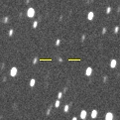
|
Now it is 16.7 mag (Dec. 3, D. Buczynski). It will stay at 14 mag for a long time from 2021 to 2022. In the Northern Hemisphere, it stays observable in good condition while brightening gradually, although it becomes low in December and January. In the Southern Hemisphere, it is not observable until March.
Date(TT) R.A. (2000) Decl. Delta r Elong. m1 Best Time(A, h)
Jan. 11 18 52.97 29 59.7 7.567 7.013 52 17.1 5:38 (245, 18)
Jan. 18 18 56.25 29 47.9 7.533 6.979 52 17.0 5:38 (248, 22)
|
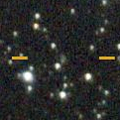
|
Now it is 16.6 mag (Dec. 27, Toshihiko Ikemura, Hirohisa Sato). It will brighten up to 12 mag in winter in 2022. In the Northern Hemisphere, it stays observable in good condition for a long time, although it becomes low from February to March. In the Southern Hemisphere, it is not observable until 2021 November.
Date(TT) R.A. (2000) Decl. Delta r Elong. m1 Best Time(A, h)
Jan. 11 22 22.96 40 30.0 7.275 7.080 74 17.3 18:36 (114, 48)
Jan. 18 22 27.59 40 24.5 7.301 7.035 70 17.3 18:42 (116, 43)
|

|
New comet. Now it is 17.5 mag (Jan. 5, Toshihiko Ikemura, Hirohisa Sato). It will brighten up to 16.5 mag and will be observable in good condition in March.
Date(TT) R.A. (2000) Decl. Delta r Elong. m1 Best Time(A, h)
Jan. 11 12 55.97 0 22.7 1.776 2.135 97 17.5 5:37 ( 0, 55)
Jan. 18 13 4.67 -0 13.4 1.698 2.132 102 17.4 5:18 ( 0, 55)
|

|
Now it is 17.8 mag (Dec. 28, Toshihiko Ikemura, Hirohisa Sato). It will brighten up to 16 mag in March, and it will be observable in good condition.
Date(TT) R.A. (2000) Decl. Delta r Elong. m1 Best Time(A, h)
Jan. 11 11 59.35 44 3.8 1.225 1.921 120 17.7 4:41 (180, 81)
Jan. 18 12 1.11 44 8.8 1.147 1.890 124 17.5 4:15 (180, 81)
|

|
Now it is 18.8 mag (Dec. 27, Toshihiko Ikemura, Hirohisa Sato). It will brighten up to 17 mag from February to March. It is not observable in the Southern Hemisphere.
Date(TT) R.A. (2000) Decl. Delta r Elong. m1 Best Time(A, h)
Jan. 11 23 44.38 -0 55.7 1.572 1.479 66 17.6 18:36 ( 48, 43)
Jan. 18 23 59.06 2 36.3 1.604 1.465 63 17.5 18:42 ( 56, 43)
|
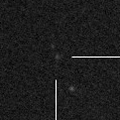
|
Now it is 17.9 mag (Dec. 5, R. L. Flynn). It is observable at 17-18 mag for a long time from late 2019 to early 2021. It will fade out before it passes the perihelion.
Date(TT) R.A. (2000) Decl. Delta r Elong. m1 Best Time(A, h)
Jan. 11 2 51.53 2 5.5 4.637 5.066 110 17.6 19:30 ( 0, 57)
Jan. 18 2 51.64 2 32.9 4.727 5.053 103 17.6 19:03 ( 0, 58)
|

|
Now it is 17.4 mag (Dec. 28, Toshihiko Ikemura, Hirohisa Sato). It stays observable at 16.5 mag for a long time from 2020 to 2021. In the Northern Hemisphere, it is observable in excellent condition for a long time. In the Southern Hemisphere, it is not observable until 2021 summer.
Date(TT) R.A. (2000) Decl. Delta r Elong. m1 Best Time(A, h)
Jan. 11 1 5.99 78 5.7 6.212 6.620 110 17.6 18:36 (176, 47)
Jan. 18 0 59.45 76 41.2 6.245 6.599 106 17.6 18:42 (173, 47)
|
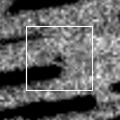
|
It is observable at 17.5 mag in good condition until spring.
Date(TT) R.A. (2000) Decl. Delta r Elong. m1 Best Time(A, h)
Jan. 11 16 4.04 -15 52.0 2.637 2.110 48 17.6 5:38 (311, 23)
Jan. 18 16 18.50 -16 25.4 2.598 2.131 51 17.6 5:38 (314, 24)
|
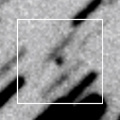
|
Asteroid moving along a comet-like orbit. Now it is 16.5 mag (Dec. 27, Toshihiko Ikemura, Hirohisa Sato). It stays observable at 17 mag from 2020 to 2021. It locates somewhat low in the Northern Hemisphere.
Date(TT) R.A. (2000) Decl. Delta r Elong. m1 Best Time(A, h)
Jan. 11 11 0.04 -25 2.7 6.225 6.627 110 17.6 3:41 ( 0, 30)
Jan. 18 10 59.79 -25 14.1 6.131 6.621 115 17.6 3:14 ( 0, 30)
|

|
Now it is 18.1 mag (Jan. 5, Toshihiko Ikemura, Hirohisa Sato). It moves along the same orbit as C/1844 Y1 (Great Comet). It approaches to Sun down to 0.25 a.u. on May 30. It is expected to brighten up to 6 mag. In the Northern Hemisphere, it stays observable in excellent condition until mid May when it brightens up to 9 mag. In the Southern Hemisphere, it is observable only until mid February.
Date(TT) R.A. (2000) Decl. Delta r Elong. m1 Best Time(A, h)
Jan. 11 11 50.31 34 12.1 2.101 2.746 121 18.0 4:32 ( 0, 89)
Jan. 18 11 51.84 36 29.3 1.938 2.648 126 17.7 4:06 (180, 89)
|
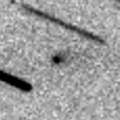
|
Now it is 17.5 mag (Jan. 5, Toshihiko Ikemura, Hirohisa Sato). It is brightening even after the perihelion passage. It will be fainter than 18 mag in January. However, it may stay bright for some more time. It is observable in good condition in the Northern Hemisphere. In the Southern Hemisphere, it is already unobservable.
Date(TT) R.A. (2000) Decl. Delta r Elong. m1 Best Time(A, h)
Jan. 11 10 48.43 51 16.2 0.962 1.773 131 17.7 3:30 (180, 74)
Jan. 18 10 51.66 54 14.7 0.981 1.802 132 17.9 3:06 (180, 71)
|

|
Now it is 17.7 mag (Dec. 31, Toshihiko Ikemura, Hirohisa Sato). It will be fainter than 18 mag in late April.
Date(TT) R.A. (2000) Decl. Delta r Elong. m1 Best Time(A, h)
Jan. 11 12 44.49 7 15.4 10.396 10.650 102 17.8 5:26 ( 0, 62)
Jan. 18 12 45.08 7 27.6 10.301 10.667 109 17.8 4:59 ( 0, 62)
|

|
It brightened up to 14 mag from autumn to winter in 2018. Now it is fading. It is observable at 17.5 mag in good condition from winter to spring.
Date(TT) R.A. (2000) Decl. Delta r Elong. m1 Best Time(A, h)
Jan. 11 13 47.24 -1 52.0 4.196 4.216 84 17.8 5:38 (340, 51)
Jan. 18 13 48.52 -2 14.7 4.124 4.257 91 17.8 5:38 (350, 52)
|

|
Now it is 16.5 mag (Nov. 29, Toshihiko Ikemura, Hirohisa Sato). It will be fainter than 18 mag soon.
Date(TT) R.A. (2000) Decl. Delta r Elong. m1 Best Time(A, h)
Jan. 11 0 54.22 -8 32.1 2.852 2.842 79 17.8 18:36 ( 22, 44)
Jan. 18 0 50.96 -8 39.4 3.033 2.880 71 18.0 18:42 ( 33, 41)
|

|
Now it is 17.0 mag (Dec. 27, Toshihiko Ikemura, Hirohisa Sato). It stays bright even after the perihelion passage. It will fade out rapidly after this, and it will be fainter than 18 mag in January. However, it may stay bright for some more time.
Date(TT) R.A. (2000) Decl. Delta r Elong. m1 Best Time(A, h)
Jan. 11 3 12.66 0 9.1 2.542 3.084 114 17.8 19:52 ( 0, 55)
Jan. 18 3 15.72 0 49.4 2.682 3.140 108 18.1 19:27 ( 0, 56)
|
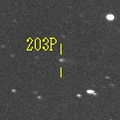
|
Now it is 16.5 mag (Dec. 28, Toshihiko Ikemura, Hirohisa Sato). It is observable at 17 mag in good condition in winter. It locates somewhat low in the Southern Hemisphere.
Date(TT) R.A. (2000) Decl. Delta r Elong. m1 Best Time(A, h)
Jan. 11 3 54.87 22 38.1 2.477 3.213 131 17.9 20:34 ( 0, 78)
Jan. 18 3 54.85 22 29.4 2.552 3.210 124 17.9 20:06 ( 0, 78)
|

|
It will brighten up to 13 mag in 2022. In 2020, it is observable at 17.5 mag in good condition in spring. It locates somewhat low in the Southern Hemisphere.
Date(TT) R.A. (2000) Decl. Delta r Elong. m1 Best Time(A, h)
Jan. 11 10 54.60 18 6.0 3.917 4.623 131 17.9 3:36 ( 0, 73)
Jan. 18 10 52.92 18 29.8 3.828 4.612 138 17.9 3:07 ( 0, 73)
|
|
![]()
 C/2019 K1 ( ATLAS )
C/2019 K1 ( ATLAS ) 114P/Wiseman-Skiff
114P/Wiseman-Skiff C/2018 W2 ( Africano )
C/2018 W2 ( Africano ) 68P/Klemola
68P/Klemola C/2018 A6 ( Gibbs )
C/2018 A6 ( Gibbs ) 2I/2019 Q4 ( Borisov )
2I/2019 Q4 ( Borisov ) C/2016 M1 ( PanSTARRS )
C/2016 M1 ( PanSTARRS ) 246P/NEAT
246P/NEAT C/2017 B3 ( LINEAR )
C/2017 B3 ( LINEAR ) 160P/LINEAR
160P/LINEAR 155P/Shoemaker 3
155P/Shoemaker 3 78P/Gehrels 2
78P/Gehrels 2 289P/Blanpain
289P/Blanpain C/2019 N1 ( ATLAS )
C/2019 N1 ( ATLAS ) 260P/McNaught
260P/McNaught C/2017 K2 ( PanSTARRS )
C/2017 K2 ( PanSTARRS ) C/2017 M4 ( ATLAS )
C/2017 M4 ( ATLAS ) 101P/Chernykh
101P/Chernykh C/2019 F1 ( ATLAS-Africano )
C/2019 F1 ( ATLAS-Africano ) C/2010 U3 ( Boattini )
C/2010 U3 ( Boattini ) C/2019 F2 ( ATLAS )
C/2019 F2 ( ATLAS ) 88P/Howell
88P/Howell C/2015 O1 ( PanSTARRS )
C/2015 O1 ( PanSTARRS ) C/2018 U1 ( Lemmon )
C/2018 U1 ( Lemmon ) C/2019 L3 ( ATLAS )
C/2019 L3 ( ATLAS ) P/2019 Y2 ( Fuls )
P/2019 Y2 ( Fuls ) 124P/Mrkos
124P/Mrkos 112P/Urata-Niijima
112P/Urata-Niijima 173P/Mueller 5
173P/Mueller 5 C/2019 T3 ( ATLAS )
C/2019 T3 ( ATLAS ) 175P/Hergenrother
175P/Hergenrother A/2019 C1
A/2019 C1 C/2019 Y4 ( ATLAS )
C/2019 Y4 ( ATLAS ) 76P/West-Kohoutek-Ikemura
76P/West-Kohoutek-Ikemura C/2014 B1 ( Schwartz )
C/2014 B1 ( Schwartz ) (944) Hidalgo
(944) Hidalgo C/2018 DO4 ( Lemmon )
C/2018 DO4 ( Lemmon ) C/2019 K5 ( Young )
C/2019 K5 ( Young ) 203P/Korlevic
203P/Korlevic 117P/Helin-Roman-Alu 1
117P/Helin-Roman-Alu 1![]()




































